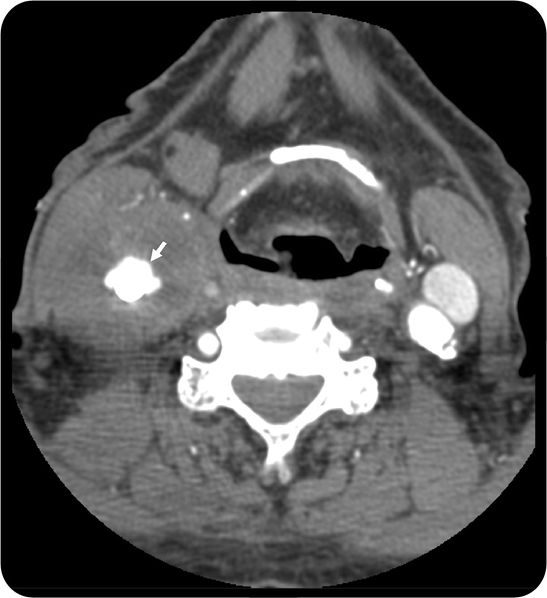An afebrile 88-year-old man with a right internal carotid artery stent inserted 2 years previously in October 2006 presented acutely with right side visual loss and neck mass. CT angiogram showed contrast extravasation surrounding the stent (figure) and a large infected hematoma encapsulating the right common and internal carotid artery. Streptococcus agalactiae was cultured from the surgically excised carotid artery tissue and right eye vitreous fluid.

Figure Carotid artery stent infection with Streptococcus agalactiae
Right internal carotid artery stent infection. There is contrast extravasation (arrow) around the stent within a large neck mass; S agalactiae was cultured from the infected carotid artery wall.
Carotid artery stent infection has been reported following neck irradiation.1 Carotid artery stent infection usually occurs after carotid artery wall injury; our case did not have an apparent injury, although we cannot rule this out.
Disclosure: Dr. Desai, Dr. Hussain, and Dr. Islam report no disclosures. Dr. Jin received a Focus on Stroke CIHR/RxD Collaborative Research Program Fellowship.
Address correspondence and reprint requests to Dr. Albert Y. Jin, Department of Medicine (Neurology), Queen's University, c/o Connell 7, Division of Neurology, Kingston General Hospital, Kingston, Ontario, Canada K7L 2V7; ayj@queensu.ca
&NA;
- 1.Kaviani A, Ouriel M, Kashyap VS. Infected carotid pseudoaneurysm and carotid-cutaneous fistula as a late complication of carotid artery stenting. J Vasc Surg 2006;43:379–382. [DOI] [PubMed] [Google Scholar]


